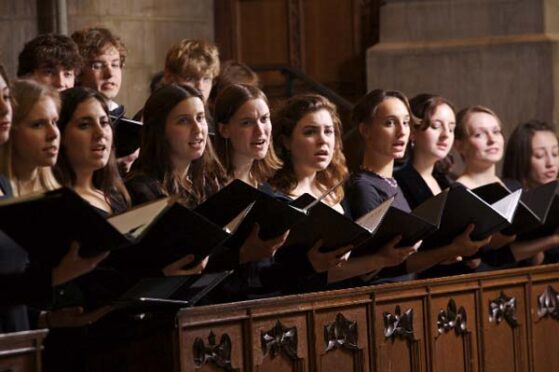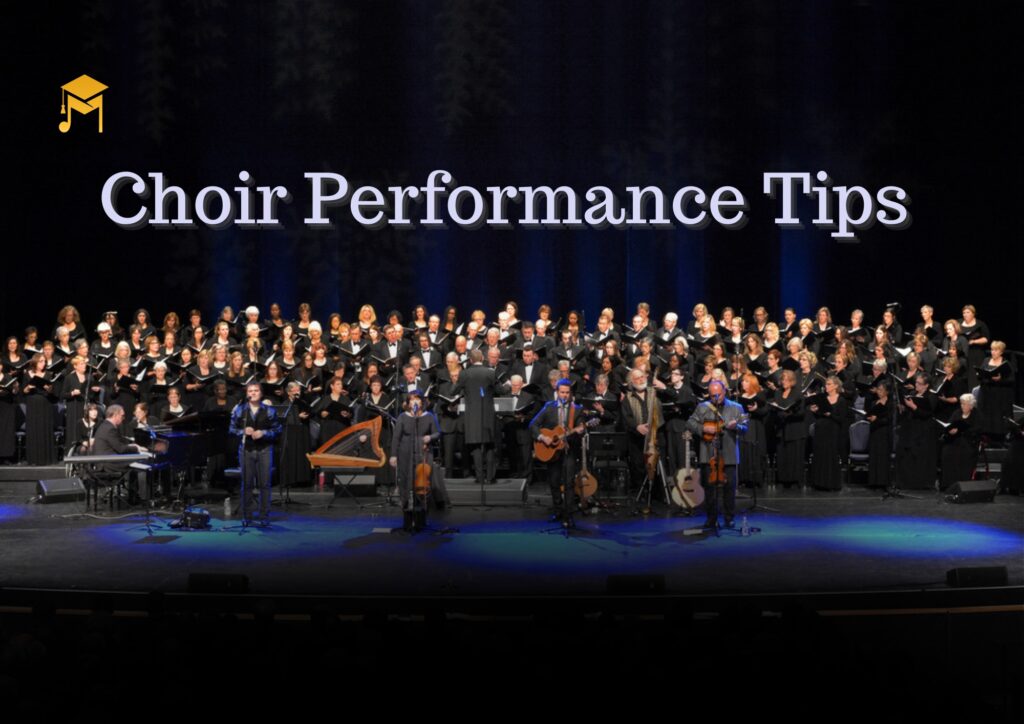Choir Performance Tips | How to Prepare for a Winning Show
Performing in a choir, whether it’s for a competition, concert, or special event, goes beyond just singing in harmony. It requires careful preparation, collaboration, and artistry to stand out. Therefore, in this blog, we’ll cover choir performance tips that will elevate your choir’s performance to a winning level, ensuring that every voice contributes to a mesmerizing and unforgettable show.
Exciting News: Choir Competition Information
Before we dive into the tips, here’s some exciting news for all choir groups looking to showcase their talent:
- Registration Deadline: December 1st
- Submission Deadline: December 15th
- Results Announcement: December 25th (Christmas Day!)
- The grand prize is a fantastic $500!
Now, let’s explore the key elements that will help lead your choir to victory! First, we’ll focus on understanding your repertoire, then move on to perfecting vocal techniques and building stage presence.

Understanding Your Repertoire
One of the most critical factors in a winning performance is the selection and deep understanding of your repertoire. Choosing pieces that highlight the strengths of your choir and resonate with your audience is essential. To begin with, here’s how to approach this:
Select Pieces with Impact: Choose songs that are not only beautiful but also have a story or emotional pull. Pieces with dynamic contrasts, interesting harmonies, and lyrical depth engage both the choir and the audience.
Next, Analyze the Music: Dive deep into the structure of the songs. Understand the tempo changes, dynamics, phrasing, and unique features. This analysis will help in executing the music as intended by the composer.
Finally, Adapt for Your Choir: Tailor the arrangement to fit your choir’s strengths, whether it’s powerful sopranos, deep basses, or agile altos. This ensures that each section can shine and contribute to the overall sound of the piece.

Perfecting Vocal Techniques
Strong vocal techniques are non-negotiable for a polished performance. Focus on training your choir in these areas:
- Breath Control: Teach singers to manage their breath to support long phrases and maintain consistent volume. Breath control also helps in creating crescendos and decrescendos that are smooth and impactful.
- Diction and Articulation: Clear pronunciation ensures that the audience can understand the lyrics. Work on consonants and vowel uniformity so that every word is delivered clearly and cohesively.
- Tonal Balance: Achieving a blend where no voice overpowers the others is crucial. Balance exercises, such as adjusting dynamics according to section and individual placement, can be helpful.
- Intonation: Regular tuning exercises should be part of rehearsals to prevent pitch issues. Singing scales, arpeggios, and interval training can help singers stay on key.

Choral Unity and Blend
A winning choir sounds like one voice, not many individuals. To achieve this unity, consider these tips:
Listen and Adapt: First and foremost, encourage choir members to listen closely to one another. This will allow them to adjust their volume and tone as needed, ensuring they blend seamlessly.
Sectional Practices: Additionally, conducting sectional rehearsals is key. This approach allows each part to fine-tune their contribution without competing with the other voices, fostering a more cohesive sound overall.
Dynamic Awareness: Moreover, it’s crucial that all sections understand the dynamics written in the music. Ensuring everyone adheres to them in a synchronized way will enhance the performance, making it more expressive and unified.

Expressive Conducting
The conductor’s role is pivotal in guiding the choir to its best performance. A conductor who is expressive and clear in their movements can inspire confidence and musicality among singers.
- Precision in Cues: Ensure that your gestures signal entries, cut-offs, dynamics, and tempo changes effectively. A confident cue can prevent missed entries and rushed tempos.
- Emotional Connection: Show emotion while conducting. If the conductor looks inspired, the choir will follow that energy and translate it to the audience.
- Facial Expressions: Use expressions that match the mood of the music. This helps choir members stay engaged and interpret the music more expressively.

Stage Presence and Movement
Stage presence is an often-overlooked but essential part of a winning performance. Choir performance tips can help your choir captivate the audience from the moment they step on stage:
Confidence on Stage: Ensure choir members walk on stage confidently with good posture, as first impressions matter and set the tone for the performance.
Strategic Placement: Arrange singers based on the venue’s acoustics. Place stronger voices at the ends for a balanced, powerful sound.
Subtle Movements: Use subtle swaying or head movements to add emotion, but ensure they complement the music without distracting from the singing.
By following these choir performance tips, your choir will not only sound great but also engage the audience visually, making for a memorable performance.

Building Emotional Connection
Winning performances make the audience feel something deeply. The ability to emotionally connect with the music and convey that feeling is a game-changer. Here are some ways to achieve this:
Storytelling Through Song: Teach choir members the background of the pieces they’re performing. Understanding the story behind the lyrics helps them express emotions more authentically.
Facial Engagement: Encourage singers to avoid blank expressions. Instead, have them mirror the song’s emotions through their faces.
Engage with the Audience: Eye contact and a shared musical experience can strengthen the connection with the audience, enhancing the overall impact.
By focusing on these elements, your choir will create a performance that resonates with listeners.

Choreographed Elements
While traditional choir performances focus primarily on vocal delivery, modern competitive and show choirs, on the other hand, often incorporate simple choreography to add a visual dimension.
Keep It Simple: Choreography should enhance the music, not overwhelm it. In fact, simple movements like hand gestures or steps can add flair and visual interest without sacrificing sound quality.
Practice Coordination: Furthermore, it’s essential to rehearse movements alongside singing to ensure proper coordination. This approach helps prevent singers from becoming distracted by the movement, which could ultimately affect their vocal performance.
Synchronize Movements: Finally, it’s crucial to ensure that all movements are synchronized. This synchronization helps maintain both professionalism and visual appeal, creating a more polished and cohesive performance.

Dress Code and Attire
The visual aspect of a performance, including what the choir wears, plays a crucial role in contributing to the overall impression. Here are some key points to consider:
Uniformity: Choose attire that makes the choir look cohesive. This could include formal robes, matching outfits, or themed clothing that complements the performance’s message.
Comfort: Ensure that the attire is comfortable enough to allow for full lung expansion and freedom of movement, enabling singers to perform at their best.
Appropriate for the Theme: If the repertoire includes a variety of genres or cultural pieces, attire that subtly reflects the music can add an extra layer of meaning to the performance, making it more impactful.

Warm-Up and Mental Preparation
Preparation on the day of the performance is just as crucial as all the rehearsals.
- Physical Warm-Up: Light stretching and posture exercises can help release any tension and prepare the body for singing.
- Vocal Warm-Up: Run through scales, lip trills, and tongue twisters to get the vocal cords ready. This also serves to refocus the choir before they step on stage.
- Mental Focus: Implement techniques like visualization and breathing exercises to calm nerves. Remind singers of their hard work and encourage them to perform with confidence and joy.

Feedback and Growth
Finally, winning is not just about one performance but continuous improvement. To foster this growth, consider the following strategies:
Record Rehearsals: Recording practices can provide valuable insights, helping to identify areas for improvement and encouraging singers to self-evaluate. This allows the choir to refine their techniques and make necessary adjustments.
Constructive Critique: After each performance, take the time to review what went well and what could be improved. Offering specific and positive feedback will motivate singers and guide them toward enhancing their skills for the next opportunity.
Stay Inspired: To keep the momentum going, attend other choral performances or watch recordings of winning choirs. This can serve as both a source of inspiration and a tool for gathering new ideas that can be incorporated into your own performances.
By consistently applying these techniques, your choir can continue to grow and elevate its performances over time.

Conclusion
A winning choir performance blends technical precision, emotional expression, and unified effort. Choir performance tips, such as understanding your repertoire, perfecting vocal techniques, building emotional connections, and presenting with confidence, are key for your choir to stand out and captivate both judges and audiences. Remember, the essence of a memorable performance lies in the passion and commitment of each member, and while striving for excellence, never forget the joy of making music together.
By following these tips, you can guide your choir toward a performance that creates cherished musical moments. Don’t miss out—register now for our Christmas Choir Competition and showcase your choir’s talent!








